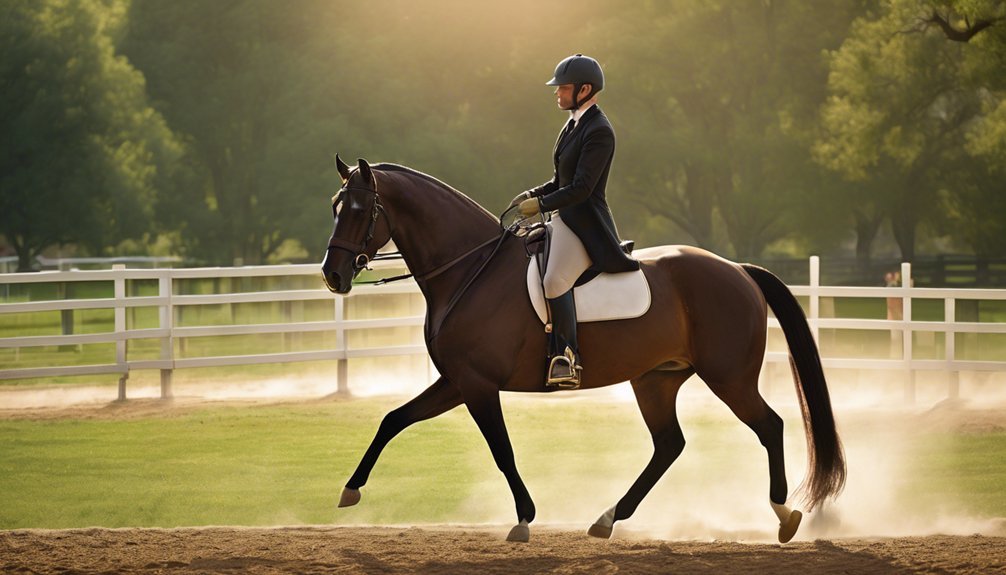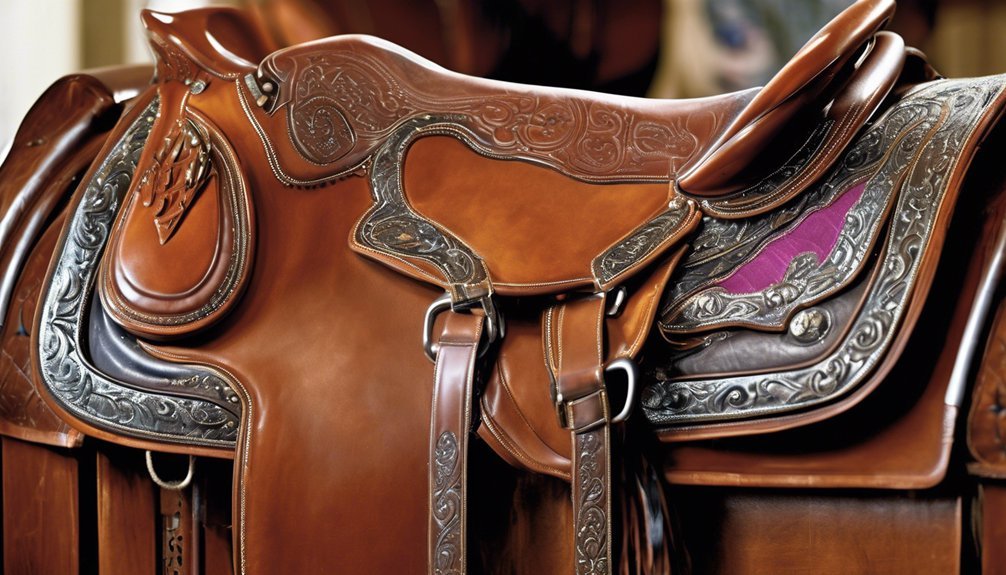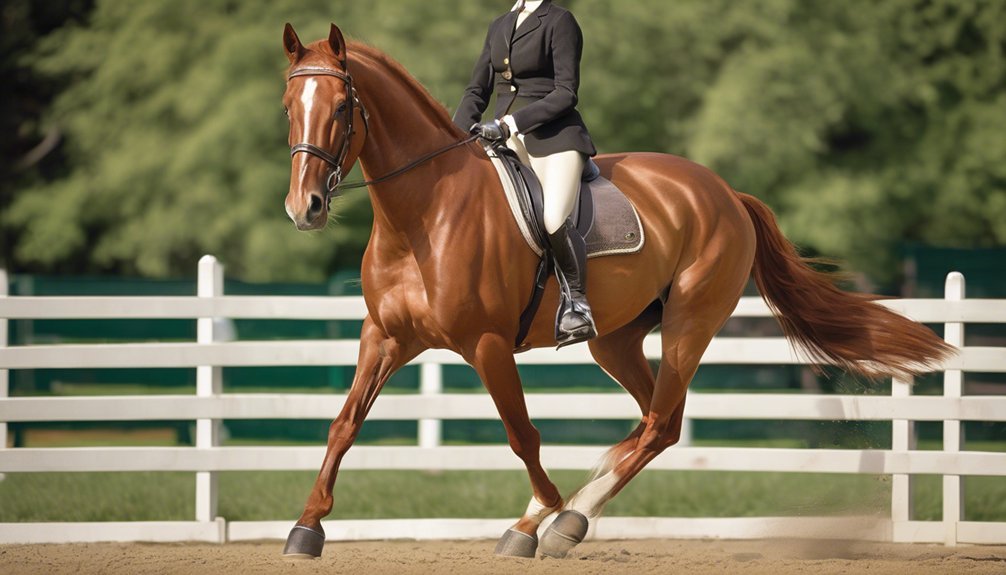
Did you know that while both dressage and show jumping involve the partnership between horse and rider, they require fundamentally different skill sets? In dressage, precision and harmony take center stage, whereas show jumping demands speed and agility. Understanding these distinctions can greatly enhance your appreciation for each discipline. What are the specific techniques that set them apart, and how do training approaches differ? Let's explore these intriguing aspects further.
Key Takeaways
- Dressage emphasizes harmony and precision through intricate movements, while show jumping focuses on speed and agility to clear obstacles.
- Dressage training involves repetitive practice of transitions and lateral movements, whereas show jumping incorporates varied courses for agility training.
- Rider communication in dressage relies on subtle cues, while show jumping requires clear signals and precise timing for successful jumps.
- Dressage movements are often performed at a slower pace to showcase elegance, while show jumping requires quick, dynamic actions to maintain speed.
- Notable figures in dressage include Anky van Grunsven, while show jumping has its own icons, highlighting distinct influences in each discipline.
Overview of Dressage

When you step into the world of dressage, you're entering a discipline that embodies the art of horse training and partnership.
With roots tracing back to ancient military exercises, dressage has evolved into a refined sport focused on harmony between horse and rider.
You'll discover the influence of famous riders like Anky van Grunsven and Isabell Werth, who've pushed the boundaries of what's achievable in the arena.
Each movement, whether it's the elegant piaffe or the precise pirouette, tells a story of dedication and skill.
Understanding dressage history enriches your appreciation for the sport, as it reflects centuries of tradition.
Embrace this journey, and you'll find a community that values the beauty of teamwork in every stride.
Overview of Show Jumping
As you explore the vibrant world of equestrian sports, show jumping stands out with its thrilling combination of speed, skill, and strategy. This exciting discipline showcases the extraordinary partnership between horse and rider, emphasizing agility and precision. Various horse breeds excel in show jumping, such as Thoroughbreds and Warmbloods, each bringing unique strengths to the competition.
Here's a quick overview of show jumping:
| Aspect | Details | Notable Events |
|---|---|---|
| Competition History | Roots in 19th-century Europe | Olympics, World Cup |
| Key Skills | Speed, accuracy, control | Quick turns, high jumps |
| Popular Breeds | Thoroughbreds, Warmbloods | Dutch, Hanoverian breeds |
Join the community of show jumping enthusiasts, and feel the adrenaline rush!
Key Techniques in Dressage
Dressage, often described as the ballet of equestrian sports, requires a deep connection between horse and rider, emphasizing harmony and precision. Mastering key dressage movements is essential for showcasing this artistry.
You'll need to focus on transitions, circles, and lateral movements to demonstrate control and communication with your horse. Your rider position plays a crucial role in executing these movements effectively; maintaining an aligned posture allows for clearer cues and a more responsive horse.
As you practice, remember that subtlety is vital; small adjustments can lead to significant improvements. Engaging in dressage not only strengthens your skills but also fosters a sense of belonging within a community that values elegance and dedication in equestrian pursuits.
Key Techniques in Show Jumping

While dressage focuses on precision and harmony, show jumping emphasizes speed, agility, and technique.
To excel in show jumping, you need to master the jumping basics. Start by developing a solid rider posture; this means sitting upright, keeping your heels down, and maintaining a relaxed grip on the reins. Your body should move fluidly with the horse, allowing you to absorb the impact of jumps.
Properly timing your release and maintaining an even pace are crucial for clearing obstacles efficiently. Additionally, practice your approach to the jump, ensuring you maintain a straight line and appropriate distance.
Training Approaches for Each Discipline
Whether you're stepping into the arena for dressage or gearing up for show jumping, understanding the specific training approaches for each discipline is essential for success. Dressage focuses on precision and harmony through repetitive training methods that enhance rider communication and connection with the horse. You'll emphasize transitions and movements, ensuring your horse responds fluidly to your cues.
In contrast, show jumping training emphasizes agility and speed, utilizing varied courses and obstacles to develop your horse's confidence and problem-solving skills. Here's a quick comparison:
| Training Approach | Dressage | Show Jumping |
|---|---|---|
| Focus | Precision and control | Agility and speed |
| Training Methods | Repetition and refinement | Course navigation practice |
| Rider Communication | Subtle cues and feedback | Clear signals and timing |
Embrace these methods to excel in your chosen discipline!
Competition Formats and Scoring
When you step into a competition, understanding the formats and scoring systems for dressage and show jumping can significantly impact your performance.
In dressage, you'll perform a series of predetermined movements, with judges scoring from 0 to 10 based on precision, grace, and harmony with your horse. The total score determines your ranking.
On the other hand, show jumping focuses on completing a course of jumps within a set time, with penalties for knockdowns or refusals. Here, your score reflects both time and faults, making it crucial to balance speed with accuracy.
Embracing these unique competition formats and scoring systems not only enhances your strategy but also deepens your connection with fellow riders who share your passion for these disciplines.
Frequently Asked Questions
What Breeds Are Best Suited for Dressage and Show Jumping?
When considering breeds for dressage and show jumping, look for characteristics like agility and temperament. Thoroughbreds excel in jumping, while Warmbloods suit dressage. Both require intensive training, so choose a breed aligned with your goals.
How Can I Transition From Dressage to Show Jumping?
Are you ready to embrace a new challenge? Shift your rider mindset and explore different training techniques. Focus on building confidence, mastering jumps, and adapting your approach to foster success in the exciting world of show jumping.
What Common Injuries Occur in Dressage vs. Show Jumping?
You'll notice that common injuries in both disciplines often involve the horse's legs and back. Focusing on injury prevention strategies, like proper warm-ups and conditioning, can help you keep your horse healthy and performing well.
Are There Age Restrictions for Competitors in These Disciplines?
Ever wondered if you can compete at any age? Both disciplines have specific age categories outlined in their competition rules. Understanding these can help you find your rightful place and thrive in the equestrian community.
How Do I Choose the Right Saddle for Each Discipline?
Choosing the right saddle means considering saddle fit and each discipline's requirements. For dressage, opt for a deeper seat; for show jumping, select a more forward flap. Prioritize comfort and performance to enhance your riding experience.
Conclusion
In the world of equestrian sports, "you can't have your cake and eat it too." Dressage and show jumping each demand unique skills and training approaches, showcasing the incredible bond between horse and rider. While dressage highlights precision and elegance, show jumping brings out agility and speed. Understanding these key differences not only enriches your appreciation for both disciplines but also helps you decide which path resonates with your equestrian aspirations. Embrace the journey, and ride on!





